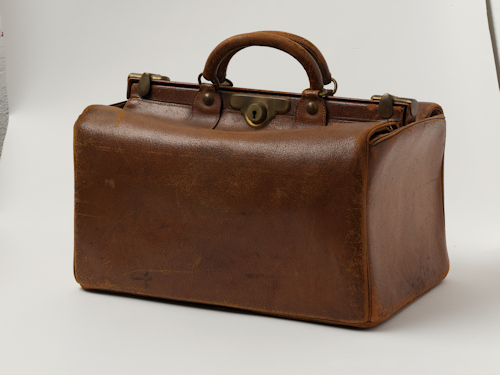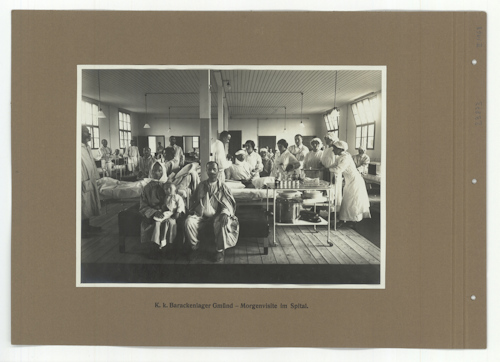“Ever fewer people,” the cynic might answer. The Who Cares? exhibition at the Jewish Museum takes a more optimistic approach and highlights the work of individuals and institutions who helped alleviate suffering in Vienna’s past.
- Strong focus on medical, psychological and socioeconomic care
- Concepts, stories & biographies
- …illustrated by historical items
- …and various works of art
- As always, implicitly thought-provoking
- Runs Jan 31 – Sept 1, 2024
- Book Jewish Museum tickets* online
- See also:
Jewish Responses to Suffering

(Among the items on display: Sigmund Freud’s doctor’s bag featuring his initials; press photo © Günter König / Sigmund Freud Private Foundation)
Throw open a newspaper these days and division dominates. More and more walls (both real and metaphorical) seem to go up between people. The Who Cares? exhibition battles the trend with a focus on compassion rather than distance.
The exhibition showcases Jewish individuals and organisations through (Viennese) history who have contributed to the relief of suffering, particularly in a psychological, medical, and socioeconomic context.
As such, the displays answer the question “who cares?” with concrete examples.
Yet the double meaning of the exhibition title also has resonance.
After all, we have a world plagued by a glaring disparity between what cultures, philosophies, politics and religions define as the “right” thing to do and how followers of each then actually behave.
The exhibition begins with suffering and care illustrated in works of art.
We see mental anguish, for example, in Uriel Birnbaum’s pictures that he created to help process his WWI trauma. And we see guardianship, for example, in Friedensreich Hundertwasser’s model of a high-rise meadow house designed for harmonious integration of people and nature.
The remaining galleries then tackle individual themes in a Viennese context while also following a broad chronology.

(View of the exhibition; press photo © Momentosphere by Tobias de St. Julien)
So we begin with the philosophical and religious background to the Jewish duty of care: for example, the concepts of charitableness and “love thy neighbour” as tenets of the Jewish faith.
Some of the (with hindsight) bizarre items used to ward off suffering then follow, including a phallic Roman amulet once owned by Sigmund Freud that sought to guard against a loss of virility. (Never change, men, never change.)
Three subsequent sections cover:
- Psychological care: a focus on Freud and his contemporaries
- Medical care: the individuals and institutions who contributed to public health
- Socioeconomic care: the individuals and organisations alleviating poverty, particularly post-WWI
A later gallery then tackles care in the context of the Nazi era, and the exhibition ends with a more contemporary reminder of the care needed by our shared planet.
Each part within Who cares? comes with historical exhibits to illustrate a personality, location, issue or institution. These exhibits include a number of notable and/or intriguing items.
As a lover of old writings, I enjoyed the certificate awarded to the Jewish woman Virdimura in 1376, allowing her to practice medicine in Sicily.
The 1930 photo of the opening of the International Congress of the World League for Sexual Reform in Vienna featured such a remarkable range of moustaches that some kind of psychological evaluation seems pertinent.
And Sigmund Freud’s doctor’s bag offers a direct link to one of the world’s great historical personalities.

(The morning round at the hospital attached to a camp for refugees in Gmünd, 1914/15; press photo © Jüdisches Museum, Wien)
Other items make less comfortable viewing. For example:
- Items misappropriated for purposes of contraception, which reminded me of photos in the Laia Abril exhibition at FOTO ARSENAL WIEN
- Bruno Frei’s photographic documentation of Jewish poverty in the Vienna of 1920
The overall theme remains broadly uplifting, though: how numerous individuals sought to take us forward, not back. To bring us together, not force us apart. A lesson for the ages.
Yet the exhibition also reminds us implicitly of humanity’s capacity for cruelty, particularly suffering imposed by sociopolitical systems and bigotry.
Inevitably, many of those simply seeking to help others found anti-semitism challenging their ability to do so.
I found myself wondering at the ridiculousness of a society where unalloyed hate and mistrust can lead to Jewish midwives of the 1830s needing a special decree to help Christian mothers-to-be with childbirth (and then only in the presence of a “pious Christian woman”).
Or a system that beheaded Catholic nun Maria Kafka in 1943 for the “heinous” crime of refusing to remove a crucifix and failing to discriminate against Jewish patients.
Dates, tickets & tips
Find out who did and does, in fact, care from January 31st to September 1st, 2024. An entrance ticket from or for the Jewish Museum includes the special exhibitions.
(Booking service provided by Tiqets.com*, who I am an affiliate of)
For those interested in Freud and psychoanalysis, well, we have a whole museum for that.
And one or two of the featured artists appear elsewhere in Vienna, too.
Lower Belvedere, for example, has a special Broncia Koller-Pinell exhibition running for much of the same time (her Mother with Child painting is part of the opening gallery to Who Cares?).
Upper Belvedere normally has a Hundertwasser painting on display. And a few weeks after Who Cares? begins, the Kunst Haus Wien reopens with a new presentation of its permanent Hundertwasser exhibition.
For more of the historical background to post-WWI Austria, particularly sociopolitical and socioeconomic developments demanding the kind of interventions documented in the Jewish Museum exhibition, try the House of Austrian History.
How to get there
Follow the travel tips at the end of the museum overview page. The main location on Dorotheergasse hosts Who Cares?
Address: Dorotheergasse 11, 1010 Vienna
